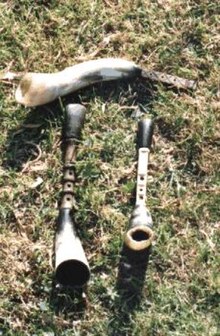Albogue
Albogue is the Spanish generic term for the traditional horn pipes that are common on the Iberian Peninsula. Albogues are instruments with a single reed , a sound tube made of wood (or tube ) having a resonance funnel from an animal horn.
The albogues are traditionally played in circular breathing .

Medieval horn pipes from Spain. Left: Alboka with semicircular bracket. Right: simple albogue (?) Illustration from the Cantigas de Santa Maria around 1300 AD.
The name albogue goes back to Latin buccinum via Arabic al-bûq (البوق) "trumpet, bugle", from which the Georgian trumpet buki also gets its name. Alboque is documented for the first time in literature in the Libro de Alexandre (13th century). However, the history of horn pipes goes back further (see Hornpipe ).
The albogues include:
- The gaita gastore ( gaita del Gastor in Cádiz ) has a body made of pear or oleander wood, which is decorated with a cross-shaped pattern, three finger holes on the top and one on the bottom and a relatively long horn as a bell. It is played at holy festivals and at Christmas.
- The gaita serrana ( gaita de la sierra in Madrid ) has a wind cap made of cow horn, a sound tube made of wood (mostly fig wood ) and square recesses in which the finger holes are located. The sound tube can have a round or square cross section. The instrument has three to four finger holes on the top and one thumb hole. The bell is also made of cow horn. The Gaita serrana was a pure shepherd's instrument that was used to pass the time. With the decline of the profession, it practically died out.
- The best-known instrument of this group is the Basque alboka with double sound tubes, which have a common wind capsule and a common horn horn. All parts of the instrument are attached to a semicircular wooden arch (see Alboka ).
- In Gascony , on the northwestern edge of the Pyrenees, the caramera ( caremère ) is played. It has a reed, a simple sound tube and an animal horn. The number of finger holes can be 6 + 1.
- The chifla de Campoo (from Campoo in Cantabria ) is not a horn whistle, but is related to the albogues. A sound tube is made from a piece of wood about 25 cm long so that it has a small wooden funnel at the top and a large wooden funnel at the bottom. The large funnel serves as a sound funnel, the upper one as a kind of wind capsule. The reed is held loosely between the lips and blown inside this windcap. The instrument has four to seven finger holes on the top.
See also
Web links
- FolkWorld # 45: Albogues. Retrieved September 4, 2016 .
- Video of an albogue player. Retrieved January 10, 2010 .
- Video Chifla de Campoo. Retrieved January 10, 2010 .
- Instrumentos pastoriles españoles # 1: Aerófonos de lengüeta simple. Retrieved January 21, 2010 .
Individual evidence
- ↑ In Galicia and Asturias , Gaita means a bagpipe .
- ↑ La Gaita Gastoreña. Instrumentos musicales antiguos. Audiovisual Chico Sánchez. Retrieved September 4, 2016 . (accessed on February 28, 2008)
- ↑ Instrumentos Tradicionales Ibéricos (accessed on February 28, 2008)
- ↑ Yan Cozian, Careméra with sound example (accessed on 29 December 2009).
- ↑ Clarinette Caramera, Landes de Gascogne (Lutherie COMDT). Retrieved September 4, 2016 .
- ↑ cf. this assembly instruction Chifla de Campoo. Retrieved September 4, 2016 . ,
